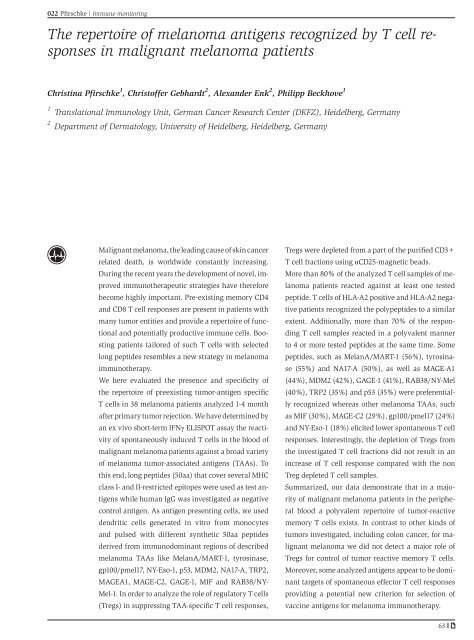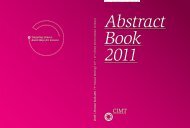Abstract Book 2010 - CIMT Annual Meeting
Abstract Book 2010 - CIMT Annual Meeting
Abstract Book 2010 - CIMT Annual Meeting
Create successful ePaper yourself
Turn your PDF publications into a flip-book with our unique Google optimized e-Paper software.
022 Pfirschke | Immune monitoring<br />
The repertoire of melanoma antigens recognized by T cell responses<br />
in malignant melanoma patients<br />
Christina Pfirschke 1 , Christoffer Gebhardt 2 , Alexander Enk 2 , Philipp Beckhove 1<br />
1 Translational Immunology Unit, German Cancer Research Center (DKFZ), Heidelberg, Germany<br />
2 Department of Dermatology, University of Heidelberg, Heidelberg, Germany<br />
Malignant melanoma, the leading cause of skin cancer<br />
related death, is worldwide constantly increasing.<br />
During the recent years the development of novel, improved<br />
immunotherapeutic strategies have therefore<br />
become highly important. Pre-existing memory CD4<br />
and CD8 T cell responses are present in patients with<br />
many tumor entities and provide a repertoire of functional<br />
and potentially productive immune cells. Boosting<br />
patients tailored of such T cells with selected<br />
long peptides resembles a new strategy in melanoma<br />
immunotherapy.<br />
We here evaluated the presence and specificity of<br />
the repertoire of preexisting tumor-antigen specific<br />
T cells in 38 melanoma patients analyzed 1-4 month<br />
after primary tumor rejection. We have determined by<br />
an ex vivo short-term IFNγ ELISPOT assay the reactivity<br />
of spontaneously induced T cells in the blood of<br />
malignant melanoma patients against a broad variety<br />
of melanoma tumor-associated antigens (TAAs). To<br />
this end, long peptides (50aa) that cover several MHC<br />
class I- and II-restricted epitopes were used as test antigens<br />
while human IgG was investigated as negative<br />
control antigen. As antigen presenting cells, we used<br />
dendritic cells generated in vitro from monocytes<br />
and pulsed with different synthetic 50aa peptides<br />
derived from immunodominant regions of described<br />
melanoma TAAs like MelanA/MART-1, tyrosinase,<br />
gp100/pmel17, NY-Eso-1, p53, MDM2, NA17-A, TRP2,<br />
MAGEA1, MAGE-C2, GAGE-1, MIF and RAB38/NY-<br />
Mel-1. In order to analyze the role of regulatory T cells<br />
(Tregs) in suppressing TAA-specific T cell responses,<br />
Tregs were depleted from a part of the purified CD3+<br />
T cell fractions using αCD25-magnetic beads.<br />
More than 80% of the analyzed T cell samples of melanoma<br />
patients reacted against at least one tested<br />
peptide. T cells of HLA-A2 positive and HLA-A2 negative<br />
patients recognized the polypeptides to a similar<br />
extent. Additionally, more than 70% of the responding<br />
T cell samples reacted in a polyvalent manner<br />
to 4 or more tested peptides at the same time. Some<br />
peptides, such as MelanA/MART-1 (56%), tyrosinase<br />
(55%) and NA17-A (50%), as well as MAGE-A1<br />
(44%), MDM2 (42%), GAGE-1 (41%), RAB38/NY-Mel<br />
(40%), TRP2 (35%) and p53 (35%) were preferentially<br />
recognized whereas other melanoma TAAs, such<br />
as MIF (30%), MAGE-C2 (29%), gp100/pmel17 (24%)<br />
and NY-Eso-1 (18%) elicited lower spontaneous T cell<br />
responses. Interestingly, the depletion of Tregs from<br />
the investigated T cell fractions did not result in an<br />
increase of T cell response compared with the non<br />
Treg depleted T cell samples.<br />
Summarized, our data demonstrate that in a majority<br />
of malignant melanoma patients in the peripheral<br />
blood a polyvalent repertoire of tumor-reactive<br />
memory T cells exists. In contrast to other kinds of<br />
tumors investigated, including colon cancer, for malignant<br />
melanoma we did not detect a major role of<br />
Tregs for control of tumor reactive memory T cells.<br />
Moreover, some analyzed antigens appear to be dominant<br />
targets of spontaneous effector T cell responses<br />
providing a potential new criterion for selection of<br />
vaccine antigens for melanoma immunotherapy.<br />
63



